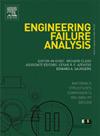钢筋混凝土带腐蚀箍筋矩形柱破坏模式转变的试验证据
IF 5.7
2区 工程技术
Q1 ENGINEERING, MECHANICAL
引用次数: 0
摘要
钢筋混凝土柱的破坏模式转换是影响柱抗震性能的重要因素。以往的试验研究忽略了箍筋间距和剪跨比的研究,这两者对腐蚀钢筋混凝土柱的破坏模式转变有重要影响。针对这一问题,研究了箍筋间距和剪力跨比对腐蚀矩形柱破坏模式转变的影响。设计了8个截面为300 mm × 450 mm的全尺寸试件,包括4种不同箍筋腐蚀比、3种不同箍筋间距和3种不同剪跨比的试件。通过分析裂纹扩展、钢筋屈服屈曲和箍筋实际腐蚀比,探讨了腐蚀柱的破坏模式。通过对腐蚀柱承载力、延性、耗能等指标的对比分析,考察腐蚀柱在不同工况下的抗震性能差异。试验结果表明:腐蚀比增大、箍筋间距增大、剪跨比减小时,破坏模式由弯曲向剪切转变;箍筋腐蚀比、箍筋间距和剪跨比对腐蚀柱的抗震性能有显著影响。在诱发钢筋混凝土柱破坏模式转变的过程中,箍筋腐蚀比和箍筋间距的增大显著降低了柱的峰值承载能力。同时,增大箍筋腐蚀比、加大箍筋间距、减小剪力跨比会导致延性和耗能下降。与未腐蚀柱相比,3种腐蚀程度下柱的位移延性系数分别降低了18.8%、5.2%和15.8%。当漂移比为3%时,它们的单周期能量耗散分别降低了15.7%、33.4%和63.1%。随着剪跨比的减小,极限状态前的累积耗能能力呈现适度下降趋势,而剪破坏前的单周期耗能能力则突然增加。该试验研究有助于理解腐蚀钢筋混凝土柱复杂的弯剪竞争破坏机制。本文章由计算机程序翻译,如有差异,请以英文原文为准。
Experimental evidence of failure mode transition for reinforced concrete rectangular columns with corroded stirrup
Failure mode transition is paramount for reinforced concrete (RC) columns with corroded stirrup, affecting the seismic performance significantly. Previous experimental studies have overlooked investigations into the stirrup spacing and shear span ratio, both of which may exert significant impacts on the failure mode transition of corroded RC columns. To deal with this problem, this study investigates the effects of stirrup spacing and shear span ratio on the failure mode transition of corroded rectangular columns. A total of eight full-scale specimens with a cross-section of 300 mm × 450 mm were designed, including specimens with four different stirrup corrosion ratios, three different stirrup spacings, and three different shear span ratios. The failure modes of corroded columns were discussed by analyzing crack propagation, steel bar yielding and buckling, and actual stirrup corrosion ratios. The differences in seismic performance of corroded columns under different working conditions were examined by comparing and analyzing results of indicators including load capacity, ductility, and energy dissipation. The test results indicate that the failure mode transition occurs from flexural to shear when the corrosion ratio increases, stirrup spacing widens, and shear span ratio decreases. The stirrup corrosion ratio, stirrup spacing, and shear span ratio significantly influence the seismic performance of corroded columns. In the process of inducing the failure mode transition of RC columns, the increase of stirrup corrosion ratio and stirrup spacing significantly reduces the peak load capacity. Meanwhile, increasing the stirrup corrosion ratio, widening the stirrup spacing, and reducing the shear span ratio lead to a decline in the ductility and energy dissipation. Compared with the uncorroded column, the displacement ductility factor of the columns under three corrosion degrees decreases by 18.8 %, 5.2 %, and 15.8 % respectively. Their single-cycle energy dissipation at 3 % drift ratio has a decrease by 15.7 %, 33.4 %, and 63.1 % respectively. In addition, the cumulative energy dissipation capacity before the ultimate state exhibits a moderate decline when the shear span ratio decreases, whereas the single-cycle energy dissipation before the shear failure experiences a sudden increase. This experimental investigation is beneficial to understanding the complicated flexural and shear failure competition mechanism of corroded RC columns.
求助全文
通过发布文献求助,成功后即可免费获取论文全文。
去求助
来源期刊

Engineering Failure Analysis
工程技术-材料科学:表征与测试
CiteScore
7.70
自引率
20.00%
发文量
956
审稿时长
47 days
期刊介绍:
Engineering Failure Analysis publishes research papers describing the analysis of engineering failures and related studies.
Papers relating to the structure, properties and behaviour of engineering materials are encouraged, particularly those which also involve the detailed application of materials parameters to problems in engineering structures, components and design. In addition to the area of materials engineering, the interacting fields of mechanical, manufacturing, aeronautical, civil, chemical, corrosion and design engineering are considered relevant. Activity should be directed at analysing engineering failures and carrying out research to help reduce the incidences of failures and to extend the operating horizons of engineering materials.
Emphasis is placed on the mechanical properties of materials and their behaviour when influenced by structure, process and environment. Metallic, polymeric, ceramic and natural materials are all included and the application of these materials to real engineering situations should be emphasised. The use of a case-study based approach is also encouraged.
Engineering Failure Analysis provides essential reference material and critical feedback into the design process thereby contributing to the prevention of engineering failures in the future. All submissions will be subject to peer review from leading experts in the field.
 求助内容:
求助内容: 应助结果提醒方式:
应助结果提醒方式:


